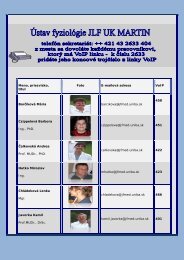You also want an ePaper? Increase the reach of your titles
YUMPU automatically turns print PDFs into web optimized ePapers that Google loves.
<strong>MAKETA</strong> 7-2 <strong>po</strong> 8.1.2008 7:10 Str. 3<br />
A C T A M E D I C A M A R T I N I A N A 2 0 0 7 7/2 3<br />
SEMI-INTERACTIVE DETECTION OF ACTION POTENTIALS USING LOCAL WAVE<br />
FEATURES AND CLUSTERING<br />
LUKÁŠ TŮMA 1, 2 , KLÁRA BERNÁŠKOVÁ 2 , JAN MAREŠ 2<br />
1<br />
4 th Department of Internal Medicine, General Teaching Hospital in Prague, Czech Republic,<br />
2<br />
Department of Normal, Pathological and Clinical Physiology, 3 rd Faculty of Medicine, Charles<br />
University in Prague, Czech Republic<br />
A b s t r a c t<br />
Impressive achievements in neuronal waveform processing branch into abundant <strong>po</strong>ol of dedicated algorithms -<br />
modifications of few core principles. This paper details design and implementation of effective customizable algorithm for<br />
detection of extracellularly recorded action <strong>po</strong>tentials demonstrated on recordings from brain cortex of adult male Wistar<br />
rats. At first signal is filtered using surroundings amplitude averaging and moving average subtraction. Subsequently,<br />
location of data <strong>po</strong>ints in which first derivation of waveform crosses zero value steeper than in common artefacts<br />
found in background activity is estimated. For description of the <strong>po</strong>int’s surroundings, amplitude and steepness with<br />
their bilateral symmetry are calculated and utilized to select graphoelements that are subsequently clustered by modified<br />
K-means algorithm. This procedure allows formation of shape patterns of action <strong>po</strong>tentials. Comprehensive offline<br />
analysis of our recordings demonstrated this approach as well utilizable for typifying and consecutive selection of action<br />
<strong>po</strong>tentials, which fluctuate due to experimental interventions. Moreover, it facilitates distinguishing activity of separate<br />
neurons in multi-unit waveforms.<br />
Key words: spike detection, clustering, action <strong>po</strong>tential, K-means, neuronal network.<br />
INTRODUCTION<br />
Automated action <strong>po</strong>tential detection and processing constitutes an inherent precondition for<br />
modern evaluation and interpretation of all recordings of electrical activity of excitable cells. In<br />
our experiment, changes in neuronal activity in cortex of the rat during development of cortical<br />
ischemic lesion caused by photothrombotic vessel occlusion were investigated [1, 2, 3, 4, 5]. An<br />
electric signal is recorded both from inside and from the vicinity of a developing ischemic focus.<br />
Changes in extracellular space are anticipated in our experiments. Therefore, alteration in shape<br />
and other characteristics of extracellular activity record of particular neuron can be obviously<br />
expected. This may be caused either by res<strong>po</strong>nse of a cell (and its neighbours) to ischemia or<br />
neuron dislocation due to development of perifocal oedema as well as its eventual lysis. The nominal<br />
impedance of registration microelectrode determines the capability to register multiple unit<br />
activity. Because of mutual displacement of electrode and tissue during recording, more than<br />
one type of cell activity can be registered and the shape of action <strong>po</strong>tential may vary in time.<br />
Indisputably, the process of detection and analysis of recordings of action <strong>po</strong>tentials is computationally<br />
intensive; sensitivity and specificity enhancement of an algorithm is burdened with<br />
increased computational complexity. Respective methods can be divided according to their complexity,<br />
the usage of artificial intelligence, fuzzy operators, clustering and the necessity of human<br />
interaction during the process of data evaluation. Peak tracking based on sole amplitude is an<br />
unsophisticated and simple method with linear time complexity [6, 7]. Employment of shape border<br />
constraints [8], or sliding clipping window determining steepness and amplitude of a peak<br />
has also been re<strong>po</strong>rted. Another method is the Maximum Integral Transform Alignment, which<br />
is based on integration of <strong>po</strong>sitive and negative part of an action <strong>po</strong>tential [9]. Graphoelements<br />
showing little variation in time can be tracked by searching for their characteristic features [6].<br />
Next technique that allows identifying action <strong>po</strong>tentials is filtration. More sophisticated methods<br />
use transformation of a signal into another domain: for example wavelet or Fourier transforma-<br />
Address for corres<strong>po</strong>ndence:<br />
Lukas Tuma M.D. Ing., Department of Normal, Pathological and Clinical Physiology, 3 rd Faculty of Medicine,<br />
Charles University in Prague, Czech Republic

















